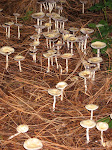
It clumps, quakes and waves. It can easily grow an inch a day. It perfectly hides snakes, birds weave it into their nests and it’s the basic energy source for many ecosystems. It’s mostly green, but under closer examination it’s often yellow, gray, blue, red and purple among other colors. It makes some people headachy and sick, while others are just fine napping in a tall field of it. So, what is “it” and why has “it” kept us too busy to post to our blog more regularly?
It is GRASS!
We’re not talking about the lovely, clipped, nitrogen-green, front lawn stuff, but a hodge-podge of heirloom species that shoot up faster than the time-lapsed, green fur on a Chia Pet. It’s lovely when it’s freshly sprouted blades, but before you know it, you can be wading in an ocean of the stuff. Deep grass is a lovely image too, however, this time of year, grass grows abundantly, and after a rare, seven inches of rain in early May, well, it’s growing into an unmanageable jungle.
Armed with power weed-eaters, scythes and heavily gloved hands, we wage war daily with the green monster. We’re on a time critical mission: We must get the green grass down and away from buildings, before the searing summer sun bakes it into a golden, fire-rich kindling. We amass mounds of the stuff and load it into the compost bins. Sometimes, when feasible, we plow it under creating a rich, green compost to improve the soil. Managing grass definitely keeps us busy.
Now, we must be fair, not all of what we cut down and pull is grass. There’s a patchwork of other green lovelies that also crisp up with the daily rising temperature. Thistles, cockleburs and many other assorted weeds add to the battle. However, we just
clump it all under the heading of “grass,”
quake at how fast it grows and
wave it good-bye for this season, knowing too well that it’ll return next year with the same determination, importance and loveliness.
(Photo: Zea species, aka Foxtails)ff77b50891c0013317d5486ac4e753715ff0ced6








